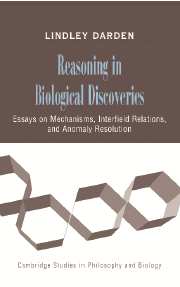 Reasoning in Biological Discoveries
Reasoning in Biological Discoveries Book contents
- Frontmatter
- Contents
- Long Contents
- List of Figures
- List of Tables
- Acknowledgments
- Introduction
- PART I BIOLOGICAL MECHANISMS
- 1 Thinking About Mechanisms with Peter Machamer and Carl F. Craver
- 2 Discovering Mechanisms in Neurobiology: The Case of Spatial Memory with Carl F. Craver
- 3 Strategies in the Interfield Discovery of the Mechanism of Protein Synthesis with Carl F. Craver
- 4 Relations Among Fields: Mendelian, Cytological, and Molecular Mechanisms
- PART II REASONING STRATEGIES: RELATING FIELDS, RESOLVING ANOMALIES
- PART III DISCOVERING MECHANISMS: CONSTRUCTION, EVALUATION, REVISION
- Bibliography
- Index
- References
1 - Thinking About Mechanisms with Peter Machamer and Carl F. Craver
Published online by Cambridge University Press: 31 August 2009
- Frontmatter
- Contents
- Long Contents
- List of Figures
- List of Tables
- Acknowledgments
- Introduction
- PART I BIOLOGICAL MECHANISMS
- 1 Thinking About Mechanisms with Peter Machamer and Carl F. Craver
- 2 Discovering Mechanisms in Neurobiology: The Case of Spatial Memory with Carl F. Craver
- 3 Strategies in the Interfield Discovery of the Mechanism of Protein Synthesis with Carl F. Craver
- 4 Relations Among Fields: Mendelian, Cytological, and Molecular Mechanisms
- PART II REASONING STRATEGIES: RELATING FIELDS, RESOLVING ANOMALIES
- PART III DISCOVERING MECHANISMS: CONSTRUCTION, EVALUATION, REVISION
- Bibliography
- Index
- References
Summary
INTRODUCTION
In many fields of science what is taken to be a satisfactory explanation requires providing a description of a mechanism. So it is not surprising that much of the practice of science can be understood in terms of the discovery and description of mechanisms. Our goal is to sketch a mechanistic approach for analyzing neurobiology and molecular biology that is grounded in the details of scientific practice, an approach that may well apply to other scientific fields.
Mechanisms have been invoked many times and places in philosophy and science. A key word search on “mechanism” for 1992–1997 in titles and abstracts of Nature (including its subsidiary journals, such as Nature Genetics) found 597 hits. A search in the Philosophers' Index for the same period found 205 hits. Yet, in our view, there is no adequate analysis of what mechanisms are and how they work in science.
We begin (Section 1.2) with a dualistic analysis of the concept of mechanism in terms of both the entities and activities that compose them. Section 1.3 argues for the ontic adequacy of this dualistic approach and indicates some of its implications for analyses of functions, causality, and laws. Section 1.4 uses the example of the mechanism of neuronal depolarization to demonstrate the adequacy of the mechanism definition. Section 1.5 characterizes the descriptions of mechanisms by elaborating such aspects as hierarchies, bottom-out activities, mechanism schemata, and sketches.
Information
- Type
- Chapter
- Information
- Reasoning in Biological DiscoveriesEssays on Mechanisms, Interfield Relations, and Anomaly Resolution, pp. 13 - 39Publisher: Cambridge University PressPrint publication year: 2006